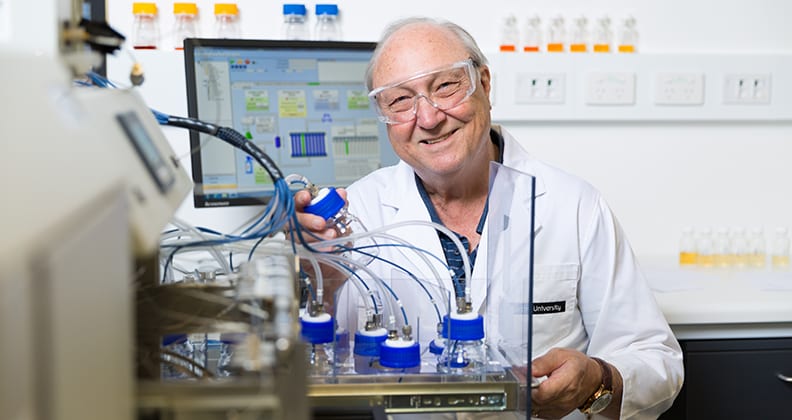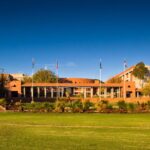Professor Neil Foster from the WA School of Mines: Minerals, Energy and Chemical Engineering is developing an improved, targeted pharmaceutical drug delivery system to treat patients with colon and lung diseases, including lung cancer – the leading cause of cancer death in Australia.
Known as ARISE (Atomised Rapid Injection for Solvent Extraction), the technology re-engineers active pharmaceutical ingredients into particles no bigger than a few micrometres, meaning they can be more easily absorbed into the body’s bloodstream than conventional pharmaceutical drugs.
Foster and his research team have already tested the delivery system’s increase in efficacy on medications including insulin; fluorouracil, which treats cancer; tobramycin, which treats bacterial infections; and fosfomycin, an antibiotic.
“One of the problems experienced by the pharmaceutical industry is the shortage of new drugs coming through the pipeline. This factor, in addition to the costs involved and the relatively short patent life, has driven pharmaceutical companies down the path of developing new delivery systems and repurposing existing drugs,” Foster explains.
If the research is successful, patients with colon and lung diseases – such as irritable bowel disease, colorectal cancer, tuberculosis, cystic fibrosis and lung cancer – will benefit by being prescribed lower dosages, thereby decreasing the drug burden on their bodies, related side effects and costs of treatment.
It could also reduce the cost of developing and gaining market approval for a new prescription medicine, which is estimated to sit at US$2.6 billion, according to a 2014 study by US non-profit research group Tufts Centre for the Study of Drug Development.
“Current treatment regimens for these disease states are inefficient, often complex and time consuming, and are associated with significant adverse side effects – all of which contribute to poor patient compliance,” Foster says.
“In the next 12 to 18 months, we’re hoping to increase our production to 100g of material a day to prove to pharmaceutical companies that our methodology works on an acceptable scale.”
How does it work?

ARISE exploits the properties of supercritical fluids and gas expanded liquid technology.
A supercritical fluid refers to a substance where both its pressure and temperature are above critical values, giving it the properties of both a gas and a liquid. The gas-like properties enable it to penetrate into a product and the liquid-like properties enable it to dissolve materials within, allowing for easy extraction.
“Using decaffeinated coffee as an example, the supercritical fluid is able to penetrate into the bean because of its gas-like properties. Its liquid-like properties enable the supercritical fluid to dissolve the caffeine. The gas-like properties then take over again, leaving the coffee bean and taking the caffeine with it,” Foster notes.
However, as most pharmaceuticals cannot dissolve in supercritical fluids such as supercritical fluid carbon dioxide (CO2), there’s an extra step involved where the pharmaceuticals are dissolved in a solvent such as ethanol before the supercritical fluid is added to the mix.
Foster explains: “As the CO2 is added, the solution physically expands. As the solution expands, the density, and therefore dissolving power, decreases. At a certain degree of expansion, the solution no longer has sufficient dissolving power to hold onto the pharmaceutical. What we then see is spontaneous crystallisation of the pharmaceutical out of the expanded solution: a gas expanded solution.
“The pharmaceutical has very small particle size, typically five micrometres and less, down to 50 nanometres, which is good for increasing solubility of the drug in the bloodstream. And the distribution of particle sizes is very narrow, which is better to predict the onset of the therapeutic effect.”
About Professor Neil Foster
Professor Neil Foster has spent the last 20 years researching, developing and commercialising innovative pharmaceutical drug delivery systems, both at Curtin and at his previous role as a chemical engineering professor at The University of New South Wales (UNSW). While at UNSW, he founded two companies – Eiffel Technologies (now known as Telesso Technologies) and BioParticle Technologies – to commercialise his research.
Foster is an internationally recognised expert in the fields of supercritical fluids and dense gas technology. In the mid-1990s, Foster and his colleague, Dr Angela Dillow from the University of Minnesota, approached MIT Professor Robert Langer, one of the world’s leading biomedical engineers, to develop a chemical agent out of supercritical fluid CO2 that can act as both a cleaning and sterilising agent. Since then, the technology has been licensed to a specialist development company, NovaSterilis, which has further developed the technology for sterilising transplanted human tissue, sensitive medical devices and other biomedical materials. Foster and Langer continue to work in collaboration to this day.
Foster’s contributions to his fields have been widely recognised:
- In 2010, he was awarded a prestigious Qian Ren (1000 Talents) Professorship by the People’s Republic of China, which encourages talented researchers from around the world to lead innovative research in China. At the time, he was the only Australia-based, non-national Chinese scholar to be recognised.
- In 2014, he was elected a member of the European Academy of Science and Arts, an independent, transnational network that seeks to solve complex issues. At the time, Foster was only one of three Australians to be awarded admission.
Over the course of his career, Foster has supervised, trained and mentored 39 higher degree research students and 24 postdoctoral researchers. His fundamental belief is that research should not be for the sake of research but should instead have a commercial focus capable of generating an outcome that benefits mankind.



